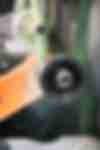What is an O-Ring?

Technical definition and fundamental characteristics of the O-Ring.
The O-Ring is a toroidal shaped ring. The term O-Ring can be broken down into “O” indicating the shape of the cross-section (in this case O, i.e. round) and “ring” indicating the ring.
Thanks to its simple shape and a wide choice of materials and dimensions, the O-Ring is an efficient and economical sealing element used for a wide range of static and dynamic applications, for double acting, axial and radial seals.
To explain the operation of an OR you need to understand Pascal’s hydrostatic principle: “in a fluid at rest in a closed container, a pressure change in one part is transmitted without loss to every portion of the fluid and the walls of the container”.
An elastomer reacts like a fluid with high viscosity. Therefore, when compression is exerted on an elastomer O-Ring, the pressure propagates unaltered in all directions of the cross-section, generating forces that counteract the pressure of the fluid to be contained allowing the seal.

“Compression and pressure exerted by the O-Ring under stress”
Classic definition according to the Deutsches Institut für Normung
DIN standards (the German Standard-setting Organisation) describe the “technical seal” as:
- Static Seal: when the seal is assured without leakage of liquids and minimum leakage of gas by diffusion.
- Dynamic Seal: when a minimum loss of liquid or gas is generated which forms a film on the coupled sliding surfaces (the minimum loss helps to lubricate the sliding parts).
How can you benefit from using an O-Ring?
Thanks to its simple shape, the O-Ring has a wide range of advantages over other sealing elements:
- it is economical and enables low-cost solutions;
- the simple design of the cavity reduces equipment design costs;
- assembly is simple and protected from tampering risks;
- it can be applied to a wide range of static, dynamic single or double-acting sealing problems;
- a wide choice of compounds is available to suit most contact fluids and gases.
+PLUS+
The first O-Ring patent is dated 12 May 1896 and was filed in Sweden by J. O. Lundberg. In the United States, however, the O-Ring patent was registered in 1937 by the 72-year-old Danish Niels Christensen, a turner who arrived in America in 1891.
Despite filing several lawsuits, his intellectual property passed from one company to another as far as Westinghouse.
During the Second World War, the US government declared the O-Ring essential for the war, allowing other companies to produce it. Niels Christensen received a payment of $75,000 and, after his death and many lawsuits, additional compensation of $100,000 to his descendants.
Would you like to find out how we produce our O-Rings?
Visit the dedicated page and discover how ORINGONE gives life to these simple products with non-standard dimensions and features, completely customizable without mould making costs.
For more information and technical details, please contact us.













































